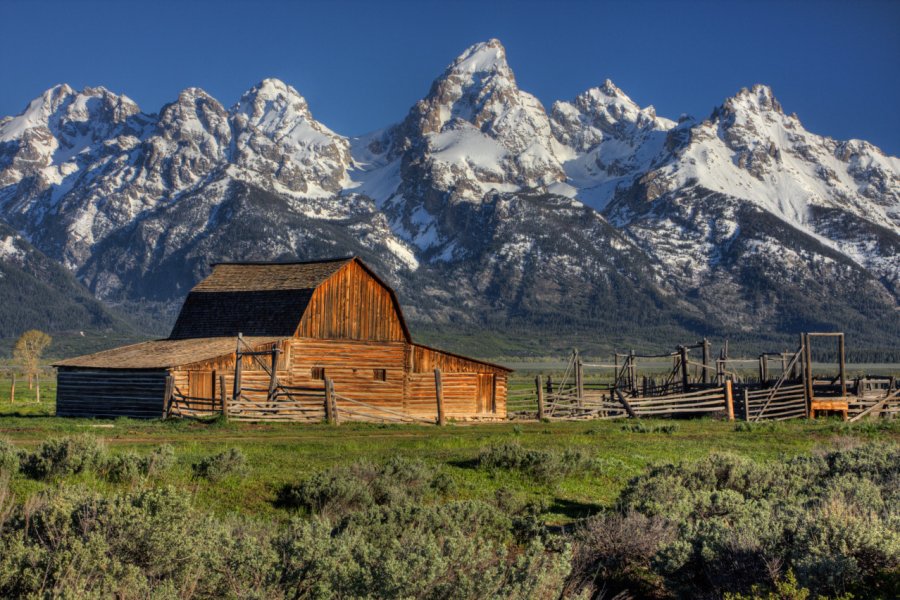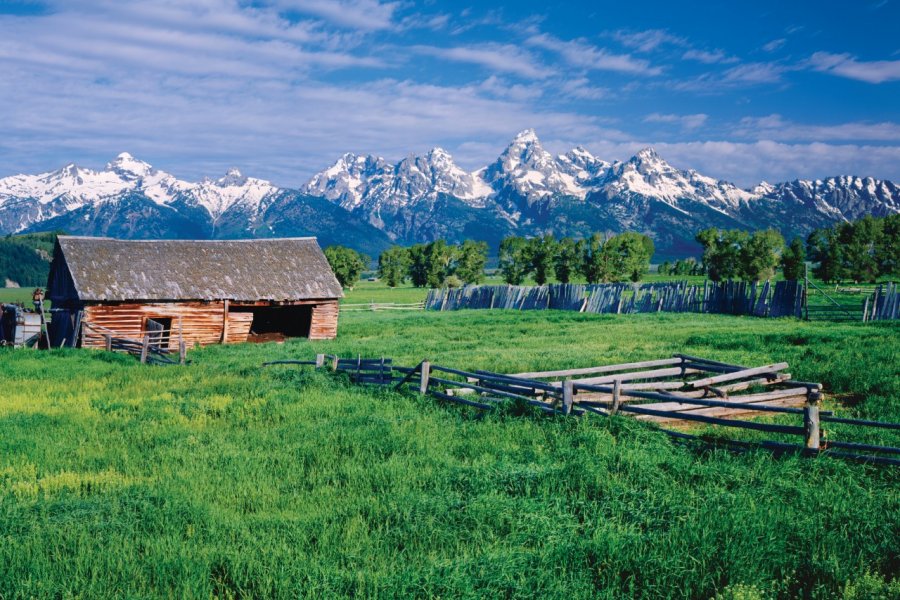Travel Guide Grand Teton National Park
Find an accommodation
Advertising
The toponym was awarded by frank Canadians to prescribe this 4,197 meter mountain summit. Grand Teton National Park covers 125,500 hectares, in the Rocky Mountains, south of Yellowstone Park and northwest Wyoming. Rising abruptly from Jackson Hole's heavenly plain and without relying on any foothills, this high chai ̂ ne crown crown stretches over several tens of kilome trees along the southwestern edge of the park, similar to a tipis line on blue blue tones. The slopes are rich in waterfalls, spreads and glaciers whose deep crevices lubricate an opaline shine. Its twelve steep peaks, reaching more than 4,000 meters, overlook a valleys or flows the Snake River. This inviolable sanctuary, or live in peace with wild animals and many skirts of birds, is surrounded by moraines lakes and alpine lakes, the largest of which, Jackson Lake, covers 10,300 hectares and has 134 meters deep! It is an ideal paradise for photographers who will enjoy the subtle points of view, but also for walkers, hikers and climbers. The Teton Park Road, housed at Highway -191, travels north to south. More than 300 kilometers of trails intersect between mountain and ripe. There are a number of ways of climbing, but it's chucked! , look at the beavers who go to their dams!GeologyThe mountains of the Grand Teton contain among the oldest rocks in North America, the main of which is a metamorphic rock, which is over 2.7 billion years old (known as gneiss), a result of seabed sediments mixed with volcanic flows that have been deep buried underground before being expelled. by collision of two tectonic plates. Heat and pressure then created a rock marked by different mineral formations separated into layers, colors and textures. Then melted magma broke into the cracks of the gneiss, some 2.5 billion years ago, and crystallized by cooling to give eruptive granite. It is this tougher rock that makes up the highest heights of the chain. Finally, the region stretched from north to south, leading to vertical cracks in the rock, and from which basaltic magma struck huge dark dikes. These formations are called diabases and are visible in particular on the east side of middleteton and on the southeastern flank of the Grand Teton.HistoryThe first human occupation of the valle would go back to about 11,000 years. For thousands of Anne Hole, Jackson Hole has been used as an important crossroads for trade, as do some of the identified itifs. They are frank explorers who give the name of "you" to the three highest summits of this choir. John Colter, who in 1808 arrived in the sector looking for beaver skins, was probably the first white man to be in this once inhospitable re-enactment or only the Shoshone Indians came, from time to time, hunting the momentum. The term "hole" was invented 1820 by fur trappers to prescribe an altitude plateau around mountains. The valle was named Jackson by David E. Jackson, a trapper famous for spending winter along the shore of Jackson Lake. The non-negotiators, trappers and breeders of French-language French-language beers pre-empted the establishment, in the 1880 s, of farmers who quickly realized that the country was too cold, too little and too much to produce satisfactory re-enactments. These first permanent settlers settled north of the city of Jackson. During these years, the re-primer acquired a national re-coup for his game and fish. It was also time for the construction of the railway.In the first inns of the xxe th base, local reagents began to fear for wildlife (especially the elites) and for the landscapes of the valle. In 1926, the re-establishment saw the arrival of billionaire (and philanthropist) John D. Rockefeller Junior, who impresses by the grandeur of the landscape, bought some 12,000 hectares of land that he then offered to the government of the day in order to make a natural re-use. In 1929, the Grand Teton National Park was recreated.ClimateThe park, which varies between 2,000 and 4,000 meters above sea level, has a mountain climate that records very high temperatures between winter and summer. Heavy snowfalls begin early in November. In winter, storms are common, days are sunny but very cold nights with a maximum temperature of -15 ° C between December and February. In the summer, however, there are beautiful days with an average temperature of 25 ° C. However, attention is paid to the remaining nights and rainfall that is frequent at this season with thunderstorms regularly at the end of the afternoon. Spring and autumn, finally, alternate between soft days, cool nights, rain and snow.NatureTo discover a lush and colorful park, covered with green meadows and with small mountain flowers, visit the summer. It is the whole nature that gives its heart joy, the birds who flush in the air, rodents who gamble in the meadows, the streams that flow peacefully and the waterfalls that discharge all their power. In the winter, however, it's a completely different scenery that awaits you on a watermelon background and buried under a thick layer of snow and ice. A more dramatic but equally photogenic show.
What to visit Grand Teton National Park?
Advertising
Suggested addresses Grand Teton National Park
Weather at the moment
Advertising
Organize your trip with our partners Grand Teton National Park
Transportation
Book your plane tickets
Car Rental
Boat rental
Accommodation & stays
Find a hotel
Holiday rental
Find your campsite
Tailor-made trip
Immersion travel
Services / On site
Activities & visits
Find a doctor
Find unique Stay Offers with our Partners
Pictures and images Grand Teton National Park
Featured articles Grand Teton National Park
Other destinations nearby Grand Teton National Park
25 km away



















